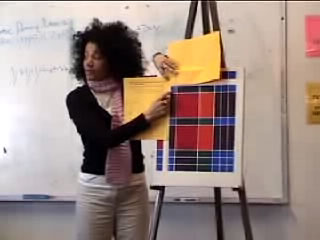Context
Where do I teach?
Content
What are my students learning?
Teaching Practice
What's my approach?
Student Work
Reflections Resources Standards
Archive |
 |
Standards
Algebra I Standards for Grade 9
- 4.0 Students simplify expressions before solving linear equations
and inequalities in one variable, such as 3(2x - 5) + 4 (x
- 2) = 12
- 10.0 Students add, subtract, multiply, and divide monomials
and polynomials. Students solve multistep problems, including
word problems, by using these techniques.
- 14.0 Students solve a quadratic equation by factoring
or completing a square.
Visual and Performing Arts Content Standards for California
Public Schools, Prekindergarten Through Grade Twelve
- 1.0 ARTISTIC PERCEPTION
- Processing, Analyzing, and Responding to Sensory Information Through
the Language and Skills Unique to the Visual Arts
- 2.0 CREATIVE EXPRESSION
- Creating, Performing, and Participating in the Visual Arts
- 2.1 Solve a visual arts problem that involves the effective
use of the elements of art and the principles of design.
- Communication and Expression Through Original Works of
Art
- 2.5 Create an expressive composition, focusing
on dominance and subordination.
- 4.0 AESTHETIC VALUING
- Responding to, Analyzing, and Making Judgments About Works
in the Visual Arts:
Students analyze, assess, and
derive meaning from works of art, including their own,
according to the elements of art, the principles of design,
and aesthetic qualities.
- Make Informed Judgments
- 4.3 Formulate and support a position regarding
the aesthetic value of a specific work of art
and change or defend that position after considering
the views of others.
- 4.4 Articulate the process and rationale for
refining and reworking one of their own works
of art.
- 4.5 Employ the conventions of art criticism
in writing and speaking about works of art.
- 5.0 CONNECTIONS, RELATIONSHIPS, APPLICATIONS
- Connecting and Applying What Is Learned in the Visual Arts
to Other Art Forms and Subject Areas and to Careers
Students apply what they learned in the visual arts across
subject areas. They develop competencies and creative skills
in problem solving, communication, and management of time and
resources that contribute to lifelong learning and career skills.
|
Site last updated
July 5, 2006
|
 The Colors of Algebra
The Colors of Algebra